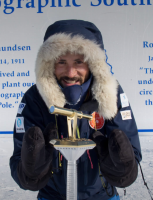Climate & Environment
Climate Change
Pollution
Natural Catastrophes
Aerosols & Particulate Matters
Air Quality
Global Warming
Greenhouse Gases Emissions
Wildfires
Post-Doctoral Fellowships
Finland
2015.12.31
Tiny Particles from Fire Have Big Climate Impact
Air quality forecasts, designed to warn you of hazardous pollution in the air, may be underestimating the risk when it comes to major fires. During a fire, a plethora of tiny particles and trace gases are released in the smoke. Tiny and trace though they may be, they add up, interact and change with time. Today’s models that predict air quality in the region near a fire tend to underestimate the number of particles, a discrepancy that researchers have to correct for. Dr. Ville Vakkari is taking an innovative approach to improving these local predictions and to understanding what it means for the global climate when these substances enter the atmosphere.
He is producing entirely new information by combining ground-based measurements of airborne particles in the smoke with satellite data capable of identifying the very fire they came from. The latter will allow him to correlate particle characteristics with the age of the fire, the type of environment it was consuming, whether it was burning with flame or quietly smoldering… All of these are clues to the type and number of particles that found their way into the air and what happened to them next.
The protagonists in this story are the aerosol particles generated by a fire. As small as a nanometer (one billionth of a meter), there are thousands of them suspended in every cubic centimeter of air. Other players are in gas form and interactions among them or with sunlight can trigger chemical reactions, potentially growing the tiny particles to climatically relevant sizes or producing a secondary set of particles. Identifying the particles present, and the balance among them, is important for Dr. Vakkari, because of their sometimes opposite effects on the climate. Soot, for example, absorbs solar radiation, leading to heating; others, including secondary particles, reflect it, causing cooling, instead. More particles in the atmosphere will also make clouds last longer and make them brighter—two factors that can lead to cooling. “For both cases, the question is how particle properties change during smoke plume transport,” he explains. Dr. Vakkari adds that “burning crop residues is a common agricultural practice around the world, but this is not necessarily a good thing.” Add that to the increased risk of natural fires due to extreme droughts linked to climate change, and we all have an interest in understanding what these tiny particles, born of fire, get up to in our air.
Scientific title : Atmospheric Evolution Of Biomass Burning Emissions
He is producing entirely new information by combining ground-based measurements of airborne particles in the smoke with satellite data capable of identifying the very fire they came from. The latter will allow him to correlate particle characteristics with the age of the fire, the type of environment it was consuming, whether it was burning with flame or quietly smoldering… All of these are clues to the type and number of particles that found their way into the air and what happened to them next.
The protagonists in this story are the aerosol particles generated by a fire. As small as a nanometer (one billionth of a meter), there are thousands of them suspended in every cubic centimeter of air. Other players are in gas form and interactions among them or with sunlight can trigger chemical reactions, potentially growing the tiny particles to climatically relevant sizes or producing a secondary set of particles. Identifying the particles present, and the balance among them, is important for Dr. Vakkari, because of their sometimes opposite effects on the climate. Soot, for example, absorbs solar radiation, leading to heating; others, including secondary particles, reflect it, causing cooling, instead. More particles in the atmosphere will also make clouds last longer and make them brighter—two factors that can lead to cooling. “For both cases, the question is how particle properties change during smoke plume transport,” he explains. Dr. Vakkari adds that “burning crop residues is a common agricultural practice around the world, but this is not necessarily a good thing.” Add that to the increased risk of natural fires due to extreme droughts linked to climate change, and we all have an interest in understanding what these tiny particles, born of fire, get up to in our air.
Scientific title : Atmospheric Evolution Of Biomass Burning Emissions
To add or modify information on this page, please contact us at the following address: community.research@axa.com

Ville
VAKKARI
Institution
Finnish Meteorological Institute
Country
Finland
Nationality
Finnish
Related articles
Climate & Environment
Climate Change
Finance, Investment & Risk Management
Societal Challenges
Climate Adaptation & Resilience
Insurance & Risk Management
Environmental Justice
Civil Society & Governance
AXA Project
Italy
AXA Research Lab on Climate Change, Risk and Justice
In response to three research questions: How can the private and financial sectors contribute to a just transition to a... Read more

Gianfranco
PELLEGRINO


